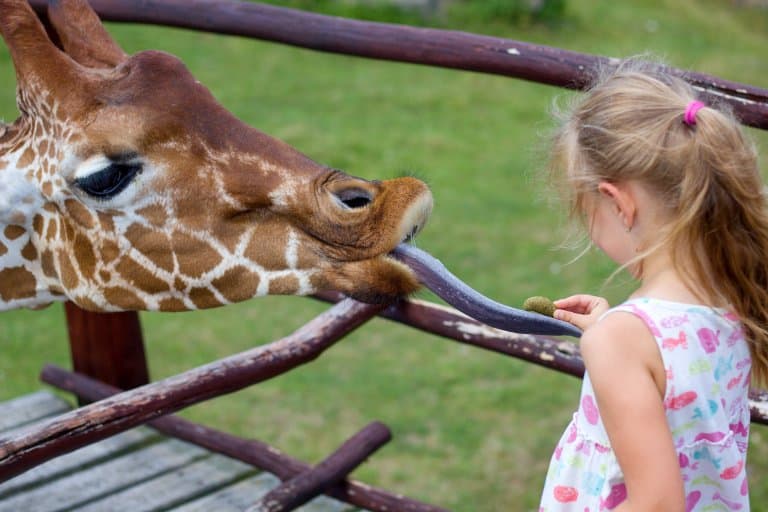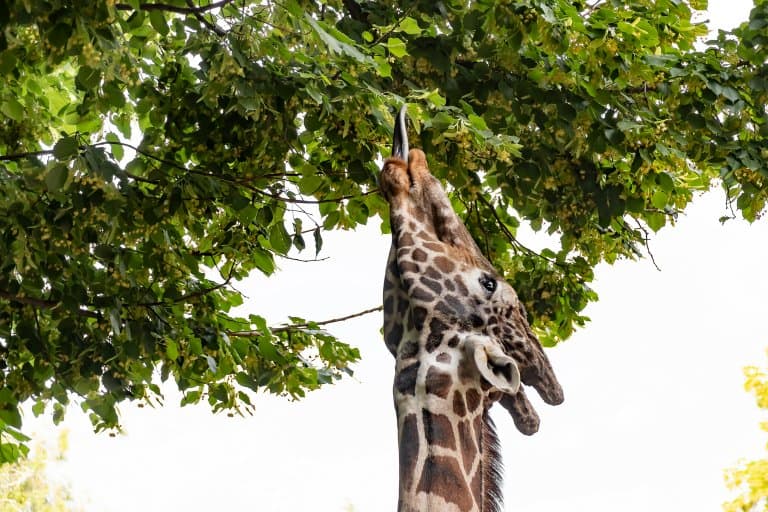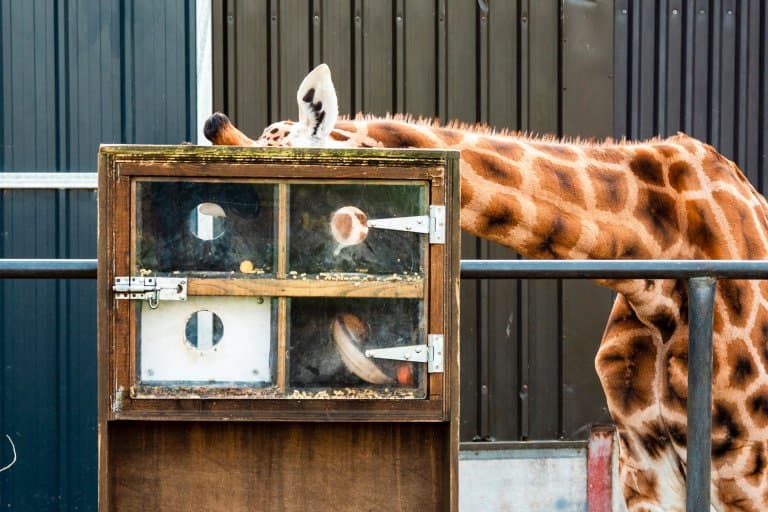Giraffes are very strange creatures with a shopping list of records among animals. They’re the largest ruminants and the tallest animals on the planet.
They have, obviously, very long necks, but what’s perhaps a little less obvious is that they have the same number of neck vertebrae as (probably) you do, and indeed any other mammals outside the three known exceptions: sloths, manatees, sloths again (two-toes sloths have 5, and 3-toed sloths have 9). These vertebrae have evolved to be 25cm (10 inches) long and hold the head up to 3m above their bodies. 1
Their heads are so far away from their hearts that it takes an enormous muscle with twice the pressure at the source and a highly adapted cardiovascular system to supply them with blood at the normal pressure.
But their uniqueness doesn’t stop there. Giraffe tongues are exceptional organs, with enough weirdness to fill a page.

So, that’s exactly what we’re going to do now. Here’s a list of epic and rather odd things about giraffe tongues.
1. Giraffe tongues are purple
The colour of a giraffe’s tongue is one of the first things you’ll notice about it. It’s not pink, like a tongue is supposed to be, instead, it’s very dark, ranging from grey to black, with a blue or purple undertone.

This pigment is only found on the front 20cm or so, which has led to the hypothesis that it’s a protective barrier against UV light for the part of the tongue that spends so long outside of the animal.
Still, this is just a guess for now, and nobody’s entirely sure why it’s this color.
2. A giraffes tongue can measure 22 inches in length
One of the other things about this tongue that’s immediately obvious is its length. They can stretch their long tongues when using them to grab leaves from trees.
A giraffe’s tongue can extend far from its mouth to a total length of around 55cm (22 inches); roughly thirteen times the length of an impressive human tongue.
This is the longest tongue of any mammal, and it comes with an extremely large mouth. 2
3. They’re also prehensile!
A famous French author once wrote “With great length comes great responsibility” and giraffes, as the best-read of all the ruminants, took it to heart.
Their tongues don’t just have immense extension, they also have exceptional control, and function as an extra limb, or hand, able to select leaves from between thorny Acacia branches. 3

4. Their tongues are fast
This control is not just for precision, but also speed. The giraffe as a whole is a relatively fast and nimble animal for how clumsy it looks, but its tongue can be rapidly withdrawn in the presence of stinging ants or other nasty insects.
5. The surface of their tongue is incredibly tough
The outer layer of a giraffe’s tongue is thick and leathery, with enlarged papillae (those tongue bumps you can see in the mirror) that act as tough, sensory pads.
Coupled with the dexterity of the tongue muscle, these help prevent injury even further while feeding on bushes that are well-defended against most herbivores. 4

6. They have effective saliva
A third line of defence comes from their salivary glands.
Giraffe saliva is thicker than ordinary spit and acts as a sticky mucous that makes kissing the lanky ruminant a truly memorable experience and coats thorns to reduce their impact.
This saliva also helps heal any injuries the tongue may pick up, as its antiseptic properties prevent infections from setting in.
7. Giraffes can’t clean their ears with their tongue
Remember when everyone was saying that the average person eats eight spiders in their lifetime?
The briefest of contemplations should lead a sensible person to wonder how anyone could possibly know this, and the same critical thinking can be applied to the bold and oft-repeated ‘fact’ that giraffes can clean their ears with their tongue.
It would be trivial to corroborate this claim with video evidence, but since there doesn’t appear to be any, we’re going to have to call this one a myth!
There is, however, plenty of video evidence of this epic tongue being used to dig around in the animal’s nostrils, which is somehow worse.
8. They’re a selection tool
All this muscular agility and toughness comes down to one thing: browsing.
While grazers have wide, lawn-mowing mouths for clipping up more or less anything green, browsers are more selective and often have more complex control over their lips and tongues.
Giraffes are highly specialised, even among browsers, and this tongue is the outcome of millions of years of evolutionary pressure to pick out the juiciest leaves among the most heavily defended plant species.
This technique provides the giraffe with up to 30kg (66lb) of the tenderest foliage from Acacia, Mimosa and wild apricots each day. 5
9. They lick urine with it
Yeah, this one isn’t quite as amazing. When a daddy giraffe loves a mummy giraffe very much, he gets down and licks her pee.
Fresh from the source, this tells the male what her reproductive status is at the moment, and whether or not she’s ready to mate with. The male will lick the pee, and then do that weird thing horses do with their lips (the flehmen response), which helps the male identify pheromone cues in the female’s urine. 6
10. They need tongue puzzles
Giraffe tongues are so complex and highly innervated that they get bored. When kept in captivity, many animals exhibit signs of stress and boredom, known as stereotypies.
If you’ve ever seen a chained elephant rocking back and forth, this is an extreme case of a poorly treated, intelligent mammal slowly losing its mind in captivity.
This is a risk in many mammals, and so good zoos provide lots of stimulation in the form of enrichment. In captive giraffes, one of the commonest stereotypies is excessive licking, and this is down to the fact that the tongue lacks stimulation when it’s not being used as it would in the wild.
So, conscientious zookeepers try to allow for natural behaviours by mimicking the complexity of feeding. They do this by making it harder to access food from the animal feeders.

This might seem cruel, but it necessitates a level of problem-solving in the giraffe, and results in a more psychologically complete animal. 7
Final Thoughts
Giraffe tongues are not just weird-looking, they’re also a phenomenal feat of evolutionary engineering. So much so, that when they’re not being used to their full potential, giraffes can struggle and become depressed.
They’re the longest tongue of any land animal, incredibly strong and dextrous, and function as a handy dipstick for a biological fertility test.
Fact Sources & References
- Bob Holmes (2021), “The Cardiovascular Secrets of Giraffes“, Smithsonian Magazine.
- Edgar M Williams (2016), “Giraffe Stature and Neck Elongation: Vigilance as an Evolutionary Mechanism“, Biology.
- Elizabeth Thibodeaux (2021), “Prehensile tongues“, Cleveland Zoo.
- Shoichi Emura (2013), “Morphology of the lingual papillae in the giraffe“, PubMed.
- Yolanda Pretorius et al (2015), “Why elephant have trunks and giraffe long tongues: how plants shape large herbivore mouth morphology“, Acta Zoologica.
- Erin Garcia de Jesús (2023), “Why male giraffes drink potential mates’ pee“, Science News.
- Loraine Tarou Fernandez et al (2008), “Tongue twisters: feeding enrichment to reduce oral stereotypy in giraffe“, Zoo Biology.
